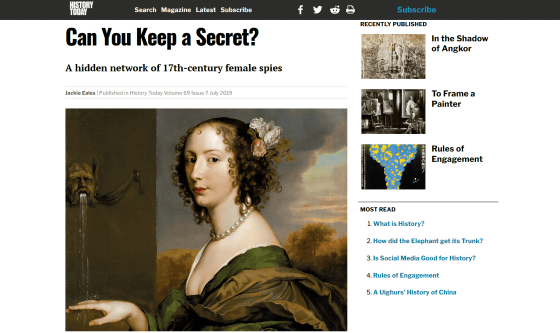What is the history of 'female spies' who were active in England in the 17th century?

Speaking of 'female spy' caught in spying during the First World War
Can You Keep a Secret? | History Today
https://www.historytoday.com/reviews/can-you-keep-secret

The Wars of the Three Kingdoms is a civil war in England, Scotland, and Ireland, triggered by the Bishops' War in 1639 due to religious affairs. In a broad sense, the Cavaliers ( Royalists) who support Charles I and Charles II of England, including the Bishops' War to the Restoration of England in 1660, and the Roundhead Party (Royalists) who aim to control the administrative organization by the parliament. ) And fought fiercely.
Elizabeth Arkin , also known as 'Roundhead Joan,' is said to have acted as a parliamentary spy in England. Arkin was hired as a spy by Robert Devereux , William Waller , and Thomas Fairfax , the wives of Francis Alkin, who was executed by the Royalists in the early days of the English Civil War, and who were influential members of the Parliament. That thing.
In 1645, Arkin received a bounty from the parliamentary faction for revealing the activities of the iron merchant George Minnes, who provided metal to the royalist, as well as the publisher of a publication appealing for the royalist. It is alleged that the person concerned was discovered. In 1649, the Royalist publication Mercurius Pragmaticus , who noticed Arkin's move, described Arkin as 'Parliamentary Joan.'
According to Nadine Ackerman, author of Invisible Agents: Women and Espionage in Seventeenth-century Britain , a compilation of 17th-century female spies, Oliver Cromwell and his spy master John Thurloe, who led the parliamentary sect to victory. The 17th-century female spies hired by Thurloe were often paid mainly as 'nurses.'

In addition to Arkin, a well-known parliamentary female spy is Lucy Hay , Countess of Carlisle. Hay gave information to the parliamentary husband, Devereux, the third Earl of Essex, that 'Charles I was trying to capture five members of the House of Representatives,' creating a factor that deepened the conflict between Charles I and the parliamentary faction. ..
On the other hand, some female spies have been active on the side of the Cavaliers. For example, Jane Warwood managed knightly female spies and coordinated knightly smuggling, while Anne Halkett rescued and dressed James the Duke of York (later James II), who had been captured by Congress. And exiled to the European continent. It is also said that Charles I, who was put under house arrest after losing the battle with the parliamentary faction, also used female spies to convey a message to the outside through a cleaner.
A woman who acted as a spy communicated information to her employer in a document that replaced political words with other everyday words to evade the eyes of others. According to Ackerman, women are unlikely to be suspected of being spies in 17th-century Britain, and although they are generally treated more generously than men when exposed to spies, women who are not protected by the upper class. The spies were at risk of violence and execution.

Related Posts:
in Note, Posted by log1h_ik







